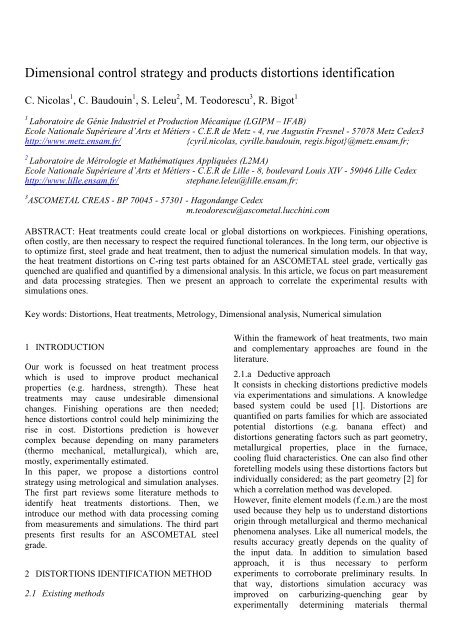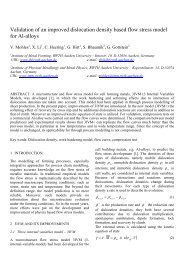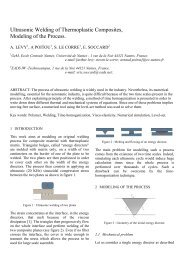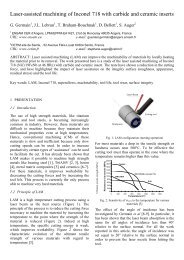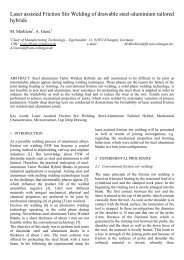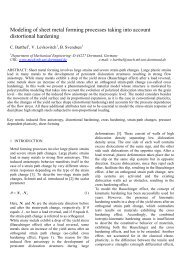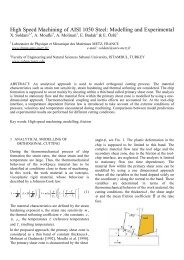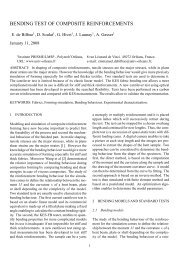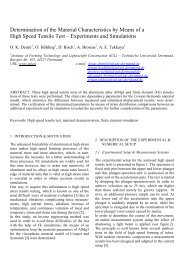Dimensional control strategy and products distortions identification
Dimensional control strategy and products distortions identification
Dimensional control strategy and products distortions identification
You also want an ePaper? Increase the reach of your titles
YUMPU automatically turns print PDFs into web optimized ePapers that Google loves.
<strong>Dimensional</strong> <strong>control</strong> <strong>strategy</strong> <strong>and</strong> <strong>products</strong> <strong>distortions</strong> <strong>identification</strong>C. Nicolas 1 , C. Baudouin 1 , S. Leleu 2 , M. Teodorescu 3 , R. Bigot 11Laboratoire de Génie Industriel et Production Mécanique (LGIPM – IFAB)Ecole Nationale Supérieure d’Arts et Métiers - C.E.R de Metz - 4, rue Augustin Fresnel - 57078 Metz Cedex3http://www.metz.ensam.fr/{cyril.nicolas, cyrille.baudouin, regis.bigot}@metz.ensam.fr;2Laboratoire de Métrologie et Mathématiques Appliquées (L2MA)Ecole Nationale Supérieure d’Arts et Métiers - C.E.R de Lille - 8, boulevard Louis XIV - 59046 Lille Cedexhttp://www.lille.ensam.fr/stephane.leleu@lille.ensam.fr;3 ASCOMETAL CREAS - BP 70045 - 57301 - Hagondange Cedexm.teodorescu@ascometal.lucchini.comABSTRACT: Heat treatments could create local or global <strong>distortions</strong> on workpieces. Finishing operations,often costly, are then necessary to respect the required functional tolerances. In the long term, our objective isto optimize first, steel grade <strong>and</strong> heat treatment, then to adjust the numerical simulation models. In that way,the heat treatment <strong>distortions</strong> on C-ring test parts obtained for an ASCOMETAL steel grade, vertically gasquenched are qualified <strong>and</strong> quantified by a dimensional analysis. In this article, we focus on part measurement<strong>and</strong> data processing strategies. Then we present an approach to correlate the experimental results withsimulations ones.Key words: Distortions, Heat treatments, Metrology, <strong>Dimensional</strong> analysis, Numerical simulation1 INTRODUCTIONOur work is focussed on heat treatment processwhich is used to improve product mechanicalproperties (e.g. hardness, strength). These heattreatments may cause undesirable dimensionalchanges. Finishing operations are then needed;hence <strong>distortions</strong> <strong>control</strong> could help minimizing therise in cost. Distortions prediction is howevercomplex because depending on many parameters(thermo mechanical, metallurgical), which are,mostly, experimentally estimated.In this paper, we propose a <strong>distortions</strong> <strong>control</strong><strong>strategy</strong> using metrological <strong>and</strong> simulation analyses.The first part reviews some literature methods toidentify heat treatments <strong>distortions</strong>. Then, weintroduce our method with data processing comingfrom measurements <strong>and</strong> simulations. The third partpresents first results for an ASCOMETAL steelgrade.2 DISTORTIONS IDENTIFICATION METHOD2.1 Existing methodsWithin the framework of heat treatments, two main<strong>and</strong> complementary approaches are found in theliterature.2.1.a Deductive approachIt consists in checking <strong>distortions</strong> predictive modelsvia experimentations <strong>and</strong> simulations. A knowledgebased system could be used [1]. Distortions arequantified on parts families for which are associatedpotential <strong>distortions</strong> (e.g. banana effect) <strong>and</strong><strong>distortions</strong> generating factors such as part geometry,metallurgical properties, place in the furnace,cooling fluid characteristics. One can also find otherforetelling models using these <strong>distortions</strong> factors butindividually considered; as the part geometry [2] forwhich a correlation method was developed.However, finite element models (f.e.m.) are the mostused because they help us to underst<strong>and</strong> <strong>distortions</strong>origin through metallurgical <strong>and</strong> thermo mechanicalphenomena analyses. Like all numerical models, theresults accuracy greatly depends on the quality ofthe input data. In addition to simulation basedapproach, it is thus necessary to performexperiments to corroborate preliminary results. Inthat way, <strong>distortions</strong> simulation accuracy wasimproved on carburizing-quenching gear byexperimentally determining materials thermal
properties [3].2.1.b Inductive approachIt consists in proposing models to identify<strong>distortions</strong> coming from experiment, mainly frommetrology. So, we need to define the number <strong>and</strong>distribution of points so that significant surfaces forthe optimization criterion would be measured withthe smallest possible loss of information [4]. Thenumber of points is subject to part size, tolerancespecifications <strong>and</strong> measurement uncertainty. Thetheoretical smallest sampling size can be used forideal geometric shape <strong>identification</strong>. But, if the formdeviation is unknown (that is our case), we have toincrease the sampling size so that estimated value ofthe measurement converges to the “true” value ofform error [5]. As for points distribution, for notcreating local weighting disturbing the optimizationmethod, it is important to dispose them uniformly.Next, we need an optimization criterion to resolvethis “data-overabundant” system. In our case ofwarped surfaces <strong>identification</strong>, a point-per-pointcomparison between measured <strong>and</strong> theoreticalgeometry is needed [6]. We chose the least squarescriterion because it gives a very stable result <strong>and</strong> isless sensitive to asperities effects [7].2.2 Developed method2.2.a Introducing C-ring test partThe C-ring type sample is currently used because itsgeometry allows us to amplify distortion which issuitable for the metrological analysis [8] [9]. We usea 100 mm long C-ring with a 16 mm wide opening.Outer <strong>and</strong> inner cylinders (respectively Ø70 <strong>and</strong> Ø45mm) are 11 mm off-centered. These dimensionsauthorize thermocouples without disturbing thermalflow; they minimize side effects <strong>and</strong> allow obtainingrequired cooling velocity [10].First, a metrological analysis occurs at threemanufacturing states: after machining, after stressrelieving <strong>and</strong> after high pressure gas quench. Then,we present a method to correlate C-ring measuredmesh with f.e.m. one in order to compare simulate<strong>distortions</strong> field with measurement’s one.2.2.b Experiment approachMeasurement <strong>strategy</strong>In order to characterise the <strong>distortions</strong> significanttypes, we define a fine mesh for the C-ring. We keepin mind that many measurement points may increasethe appearance of abnormal points but we coulddetect them via a graphic interface (see section 3).Points are evenly distributed on all surfaces (figure1), but not on the putting plane (bottom one).Outer cylinder1722 points1722 pointsInner cylinderUpper planeBottom plane110 pointsRight line38 pointsLeft lineFig. 1.Fine mesh for points probing21 points21 pointsData processing <strong>strategy</strong>Our mathematic approach is to optimize, for eachpoint i, the measure error ε i between theoreticalpoint T i <strong>and</strong> measured point M i , orthogonallyprojected onto theoretical normal N i (equation (1)).⎛ ε1⎞⎜ ⎟ with :r M⎜ ⎟r ε = εiεi= ( ΟΤi− ΟΜi).Νi(1)⎜ ⎟⎜ M ⎟ Νi= 1⎝εn ⎠In referenceframer( Ο,i, j)We also define the matrix M ph of optimizationphenomena (equation (2)). Its scalars correspond tothe phenomena elementary amplitude effect (e Phnj )on the theoretical points written in column. Thedescription unit of phenomena would be close totheir estimated value, so the millimetre.ΜphΤxΤyK PhΟΤ1eTxeTyK ePh1 1=ΟΤMjeMTxeMej TyK K Mj PhΟΤM eMeMKKeMnTxnTynPhnn1n jnnwith Τx=eeTTx jy j= Τx.Ν= Τy.ΝjjΤy= 1mm= Ν . x= Ν . yTo dissociate phenomena, those must bemathematically independent <strong>and</strong> linearlysuperimposable. In metrology, the size order of thedefects is often small compared with nominaldimensions of the measured part <strong>and</strong> so, we will usethe small displacements assumption.Finally, equation (3) gives the residual r to minimizeusing the least square criteria thanks to any solver.jj(2)
= ε −a. Ph1− b.Ph2− c.Phi−...− n.Phnwith elementary quantities (a, b, c,..., n) of significantdisplacements <strong>and</strong> <strong>distortions</strong> phenomena ( Phi,..., Phn)(3)Experimental deviceOur coordinate measuring machine (CMM) has anindication error for length measurement defined byE=(3.5+L/350)µm, L in mm.Extension barTP20 probeStar stylusC-ringFig. 2. Experimental <strong>control</strong> devicePositioning deviceWe use a dynamic probe (TP20) with a star stylus<strong>and</strong> an extension bar (figure 2). Combined withprobe head rotations, we can access all surfaces. But,even with rotations, we do not obtain a uniformdistribution of points for the inner cylinder. We thuschecked the accuracy of our device compared with asingle TP20 probe (without extension bar <strong>and</strong> starstylus) in measuring a 44.99mm st<strong>and</strong>ard ring(table1). To succeed, we optimize the 108 points ofCMM with Tx-Ty <strong>and</strong> dilatation vectors.Table1. CMM measurements of a st<strong>and</strong>ard ring diameterValues in mm Single TP20 Our TP20 deviceDiameter 44.989 44.989Range 0.006 0.0052.2.c Processing of finite element simulationWe use Forge 2005 software to make 3D-quenchsimulations for which the input data are partlyexperimentally determined (the phase transformationkinetics, the heat transfer coefficient) <strong>and</strong> partlyfrom the literature (the mechanical data) [12].Data processing <strong>strategy</strong>For a direct comparison between experimental <strong>and</strong>simulation results, we use the method previouslypresented. For instance, this method is applied foronly the cylinders. By using “2D-cutting planes”, weexport sections’ boundary geometry at the sameheights as for CMM measured C-ring. However, wemust keep in mind that CMM measurement pointsare obtained by probing the surface following thetheoretical normals. But during simulation, nodesmove on all directions. So, we have to find theintersection point S 12 between theoretical normals T 1<strong>and</strong> finite element frontier (S 1 S 2 ).Fig. 3. Intersection point S 12 between (S 1 S 2 ) <strong>and</strong> D linesUncertainty due to the methodThe method generates a quantifiable error ε s due tothe linear approximation between two consecutivenodes of the finite element frontier (figure 3). Tominimise this error, we look for the 2 simulationpoints (S 1 <strong>and</strong> S 2 ) whose angular coordinates are asclose as possible to theoretical point (T 1 ) ones. Infigure 4, we show that higher is the sampling size;higher is the accuracy. This last also increase whenthe diameter size is smaller for the same samplingsize.Error in mm betweentheoretical <strong>and</strong>identifyed diameters0,0400,0300,0200,0100,000Evolution of diameter <strong>identification</strong> error Evolution of diameter <strong>identification</strong> e0,040Outer section0,030Inner section0,0200,0100,00082 91 121 181 362 723Number of points from a cylinder section82 91 121 181 362 723Number of points from a cylinder sectionCase 1: Simulation nodes are theoretical Case 2: Simulation nodes are theoreticalpoints of outer <strong>and</strong> inner diameters points of dilated diameters (0.5mm)Fig. 4. Uncertainty due to data processing of simulation pointsInitial geometry for quench simulationWe must take into account C-ring dilation due toheating (at 930 °C). We consider for the studiedsteel grade a linear dilatation value of 22.3 µm/m/°Cin austenitic phase. Then, we create the same meshas for experimental analysis, consisting of 98sections with 400 nodes for each cylinder’sperimeter. This fine mesh aims to minimize theuncertainty of our method.3 FIRST RESULTSA software based on the described method wasdeveloped. Thus, numerical <strong>and</strong> 3D-<strong>identification</strong> of<strong>distortions</strong> phenomena can be calculated. For abetter visual underst<strong>and</strong>ing, a scale factor is appliedon the errors onto the theoretical normals (figure 5).Theses measure errors include displacementsphenomena, like translations, rotations <strong>and</strong> offcentringof the inner diameter (due to machining).By deleting them, we did what is often called best
fit, to better visualize distortion <strong>and</strong> to write their3D-mathematical expression (figure 6).Measured part grade 1, at 20°CSimulated part grade 1, at 20°CResidual in percent100806040200InitialTx, Ty, Rx,Ry, Rz+ x,y Offcentring+Pincers'openingMeasured partSimulated part+ Barrel + x,y + BananaovalizationFig. 8. Residual evolution in function of cumulated phenomenaPincers’ openingScale factor: 50 Theoretical points Quenched pointsFig. 5. Graphic comparison of best-fitted quenched geometriesAll phenomena have physical origins, as the pincers’opening which comes from a gradient of thermalstresses induced by the thickness <strong>and</strong> temperaturegradients <strong>and</strong> the steel phase transformations.PhenomenaOvalization(also dilation)Pincers’opening (orclosing)Barrel (orbobbin)Banana⎧e⎨⎩ zMathematical expressionsFor each section :y2eoval= Ν . .x j jΝjx = Νxjz x2e = ΝyovalyjjFor each section :⎧αj⎪eopen= 1−cosj⎨2⎪⎩αj= −Atan2(OTj.y;OTj.x)jFor each generatrix := 1 − zjj= −1+ 0.1 × k , k ∈barrel⎧Ifyci≥ 0; e⎨⎩If yci< 0; ebananajbanana j22= Νy× e2= −Νy× e[ 0,20 ]barreljbarreljVectors effects on errors ontotheoretical normalsyzα -αzzxxxTheoretical pointsScale factor = 5Theoretical pointsScale factor = 5Theoretical pointsScale factor = 5Theoretical pointsScale factor = 5y ceyci zFig. 6. Linear <strong>and</strong> independent 3D-distortion phenomenaA comparison between experimental <strong>and</strong> simulationresults (figure 7) show that <strong>distortions</strong> values of theouter cylinder are greater than inner ones (except forbarrel effect). Pincers’ opening is the most importantphenomenon in experiment just as barrel <strong>and</strong> bananaeffects in simulation.Elementary quantities in mm0,60,50,40,30,20,10,0-0,1-0,2Exp. Simu. Exp. Simu. Exp. Simu. Exp. Simu. Exp. Simu.X-OvalizationY-OvalizationPincers'openingBarrelBananaFig. 7. Results for 3D-<strong>distortions</strong> <strong>identification</strong> fromexperiment <strong>and</strong> simulationx cex ciInner cylinderOuter cylinderThe chosen vectors for phenomena explain the main<strong>distortions</strong> as the final residual is small (figure 8).4 CONCLUSIONSWe developed a method for identifying <strong>distortions</strong>based on the optimisation of the measure errors bythe mean of <strong>distortions</strong> significant phenomena. Inthis first approach, tendencies of these phenomenaare quite the same in experiment <strong>and</strong> simulation butwe have to refine input data of the models for abetter quantitative evaluation. Further work willfocus on many experiments <strong>and</strong> on simulationsincluding mechanical experimental data.REFERENCES1. P. Lamesle, E. Vareilles <strong>and</strong> M. Aldanondo, Towards aKBS for a Qualitative Distortion Prediction for HeatTreatments, In: Proc. 1 st Int. Conference on DistortionEngineering, Bremen (2005) 39-47.2. C. Andersch, M. Ehlers, F. Hoffmann <strong>and</strong> H.-W. Zoch,‘Systematic Analysis of the Relation between PartGeometry <strong>and</strong> Distortion due to Heat Treatment’, Mat.-wiss. u. Werkstofftech., 37, (2006) 23-28.3. R. Mukai <strong>and</strong> D.-Y. Ju, ‘Simulation of Carburizing-Quenching of a Gear. Effect of Carbon Content onResidual Stresses <strong>and</strong> Distortion’, Journal de PhysiqueIV, 120, (2004) 489-497.4. A. Weckenmann <strong>and</strong> M. Knauer, The Influence ofMeasurement Strategy on the Uncertainty of CMM-Measurements, Annals of the CIRP, 47, (1998) 451-454.5. G. Lee, J. Mou <strong>and</strong> Y. Shen, ‘Sampling Strategy Designfor <strong>Dimensional</strong> Measurement of Geometric FeaturesUsing Coordinate Measuring Machine’, Int. Journal ofMachine Tools <strong>and</strong> Manufacture, 37, (1997) 917-934.6. C. Baudouin, R. Bigot, S. Leleu <strong>and</strong> P. Martin, ‘GearGeometric Control Software: Approach by Entities’, Int.Journal of Advanced Manufacturing Technology, 2007.7. H.T. Yau <strong>and</strong> C.H. Menq, ‘A Unified Least-SquaresApproach to the Evaluation of Geometric Errors usingDiscrete Measurement Data’, Int. Journal of MachineTools <strong>and</strong> Manufacture, 36, (1996) 1269-1290.8. R.A. Hardin <strong>and</strong> C. Beckermann, Simulation of HeatTreatment Distortion, In: Proc. 59th Technical <strong>and</strong>Operating Conference, Chicago, (2005).9. Z. li, B.L. Ferguson, X. Sun <strong>and</strong> P. Bauerle, ‘Experiment<strong>and</strong> Simulation of Heat Treatment Results of C-RingTest Specimen’, In: Proc. 23rd ASM Heat TreatingSociety Conference, Pittsburgh, (2005) 245-252.10. M. Teodorescu, J. Demurger <strong>and</strong> J. Wendenbaum,Comprehension of Cooling Distortion Mechanisms bythe mean of F.E. Simulation, In: Proc. 15th IFHTFE,Vienne, (2006).


